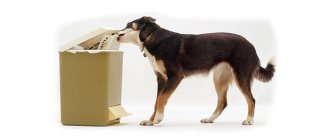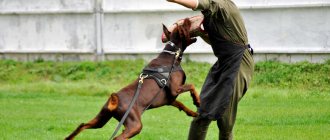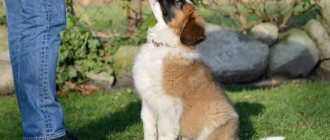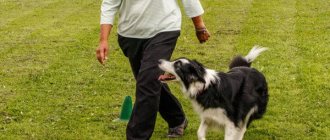(3 ratings, average: 4,33 out of 5)
Total 980 Today: 1
Basic commands for dogs are extremely important. Your dog must be able to behave correctly. Since this greatly facilitates caring for the animal and communicating with it. Sometimes, the correct skills in mastering basic commands can save your beloved pet’s life. Here you can find out which commands are mandatory for your dog. How easy it is to teach her to do them.
Do you think that your dog behaves perfectly because it doesn’t bother people and hasn’t chewed or broken anything yet? This is a completely wrong approach to raising a pet. Training is necessary; it disciplines the animal. Helps the owner find a common language with his dog and give him the necessary behavior patterns in a given situation.
What dangers await a dog at home and on the street! Stop the animal in time, call it to you, prevent it from running away and getting lost... You never know what situations arise during a walk. This is a real opportunity to walk peacefully and enjoy the world around you. Because you will be confident in your dog - it will not do anything bad to other people. No one can hurt her. Just one word and the dog will obey you.
In addition, joint activities will bring great pleasure and will significantly strengthen the bond between the animal and the owner. Here are the 8 most important basic commands that you can use in your everyday life.
List of basic commands for each day:
- Sit
- Lie
- Stand
- It is forbidden
- Give
- Near
- To me
- Place
These commands are part of a general training course, which consists of teaching the dog various skills, including 11 basic commands. We won't touch on some of them in this article. For example, the command “Fas” or “Aport”. They are not as important in everyday life as those listed above.
Conditions for training
To train, a dog must first of all be healthy, have a good appetite and be active. If your pet is not feeling well, you should not force him to exercise, this will lead to negative reinforcement of training.
It is recommended to conduct training sessions with your dog every day, if possible, at approximately the same time. The daily and training regimen, knowing the sequence of events will help the dog tune in to training more easily.
The optimal time for training is one and a half to two hours before meals or one and a half to two hours after meals.
It is important to establish eye contact between the owner and the dog; it must be concentrated on the activity. External irritants should be avoided: extraneous noise, people, other animals
Therefore, the place for training, the training ground, must be at a sufficient distance from a noisy road. When training is carried out simultaneously by several owners with their pets, the area should be spacious enough
External irritants should be avoided: extraneous noise, people, other animals. Therefore, the place for training, the training ground, must be at a sufficient distance from a noisy road. When training is carried out simultaneously by several owners with their pets, the area should be quite spacious.
What you need for training
For training you will need:
- Collar;
- Standard leash up to one and a half meters long (roulette leash is not suitable for training);
- Treat for encouragement;
- The dog's favorite toy is an option for praise;
- Training harness (as additional equipment for practicing the “Sit” command when moving);
- A strict collar is necessary only if, due to the characteristics of the breed or character, the dog does not obey and behaves aggressively.
Which delicacy to choose
First of all, the delicacy should not be harmful: cheeses, sausages, fatty meats, sweets, and pickles are excluded. At the same time, it must be tasty, the dog must want this “bait”.
The animal's daily food is not used as a reward. It is optimal to use finished product treats: dried meat, tendons of proven brands, which can be purchased at a pet store. You can independently prepare diced vegetables and fruits, pieces of boiled or scalded meat that the animal loves.
The treat should be small and easy to swallow, as the goal is to train the dog, not feed it. Tidbits should be easy to store and transport, such as in a small belt pouch.
The most common commands for a civilian dog
Each animal owner chooses which commands to teach it. There are about ten of them that are most often used in everyday life. The remaining commands are not needed for civilian dogs, since they are suitable only for service animals.
How to teach a dog commands from the civil list? You need to be patient and follow the following recommendations:
"Voice". Despite the fact that this is one of the most useless commands, many dog owners start training with it. To teach this command, you need to take a treat in your hand and show it to your pet. He will want to take it, but you cannot give him food. You need to say “Voice” and wait for the pet to bark. This exercise should be performed for 15 minutes each. After some time, the pet will learn to complete the task without food reward. "Sit". This command is the easiest to teach a dog. You need to put a collar and leash on your pet. Then you need to ensure that the animal is at the right hand of the owner. Then you need to bend your arm so that your palm is facing forward. The owner says “Sit” and at the same time presses on the animal’s croup with his left hand, and with his right hand pulls the leash up. After the dog completes a task, it needs to be rewarded. "Lie". This command begins to be taught after the “Sit” command has been learned. A collar and leash are put on the dog. The owner takes the leash in his hand so that it hangs to the floor. After this, he gives the command “Lie down” and presses with his foot on the free part of the leash, pulling the collar to the ground. After the dog lies down, you need to hold it in this position for some time, repeating the command in a firm voice. "Place". Quite a useful command. You need to start training your dog by choosing a place for it. Then you should take your pet for a walk so that he gets tired. When the dog wants to rest, it must be moved to the chosen place and given the appropriate command. The action must be repeated until the skill is consolidated. This happens quite quickly. "To me". This is a team from the mandatory set of modern training. How to teach a dog the “Come to me” command? You need to take a treat in your hand, show it to the dog and firmly say the command. When your pet approaches, you should definitely give him food and pet him as a reward. In order for the dog to better understand what exactly is wanted from it, you need to gradually complicate the task, but this should be done only after it has learned to carry out the “Come to me” command without a leash. "Ugh". This is an unconditional order to stop performing unwanted actions.
It is important to remember that this command should only be used when absolutely necessary. The easiest way to teach this command is to a puppy.
The baby will constantly stick his nose where it shouldn’t. If the owner says “ugh” to him and pulls him back, then the puppy will understand that he is performing a bad action. During the training process, light spanking is allowed to motivate refusal of action, but strong blows are unacceptable. "Near". This is another useful command. Its essence is that the pet walks nearby without a leash. To teach this command, you need to give the dog a good walk. After she gets tired, you should attach a leash to the collar. Then, the word “near” with jerks of the leash will stop any attempts by the pet to lag behind or run ahead. If the animal obeys, then you must praise it. You need to understand that such training cannot be done at home.
What is the “Aport” command used for?
It is completely clear why the commands “Come to me”, “Sit” or “No” are needed, for example. Why does a dog need to know the “Fetch” command, since it doesn’t seem to be that important? Let's consider why it is still worth teaching your pet to fetch various things:
- Running after a thrown object and bringing it back to the owner, the dog wastes its energy
[1]. In other words, this is an excellent training for the animal, prevention of obesity and diseases of the musculoskeletal system; - Teaching the “Fetch” command is not a routine, but a real game
[2], when the owner and his dog are on the same cheerful wavelength; - Executing the “Fetch” command is a great way to teach your dog to think logically
[1]. During the training process, the animal understands that it is required to first follow a thrown object, then take it in its teeth, and then return it to its owner. Exactly in this sequence; - It is worth teaching a dog to fetch various objects, if only so that the animal can control its own emotions
[1]. Of course, at first the pet will want to grab the toy and run away with it away from the owner, but over time he will understand that everything should go according to a plan clearly planned by the owner; - Dogs that have learned the “Fetch” command are well oriented in space
. They are able to clearly track the direction where a toy or other object was thrown; - Finally, a dog that knows the “Fetch” command very well can, if the owner wishes, be a real helper in the household
. So, your pet can be taught to fetch slippers or, for example, a newspaper.
How to teach a dog the command “Near!” on a leash
Start practicing the command “Near!” This is necessary after the puppy has learned to walk on a leash and has recognized the authority of the owner. The first classes should take place in a calm, familiar place, without noisy groups of people rushing past cars and other distracting objects.
Take the leash in your hands and start moving forward with the dog. Command “Near!” and pull the leash so that the pet takes the desired position near you. Walk a few steps this way and then release the tension. If your pet walks next to you and on a loose leash, praise him. Words of admiration and approval will be enough, because after seeing the treat, the dog may forget about everything and stop. If the dog moves to the side, then repeat the command “Near!” and pull him towards you with a leash.
The dog will quickly remember the feeling of discomfort associated with the tug of the leash, while the salvation from it will be movement next to your leg. It is necessary that the jerk is noticeable, but not painful for the pet, otherwise it may feel depressed or aggressive.
The first stage of training can be considered completed if, on command, the pet moves parallel to you, even if it is only a few steps.
Important: give the command “Near!” in a calm and confident voice, without shouting or anger. Make sure that the tension on the leash is gradual, without sudden jerks, and commensurate with the size of the dog.
Teach your dog to walk side by side in a straight line, at the same speed. When your pet gets used to it a little, loosen the leash, take 1 step to the side and tell him “Go for a walk!” When you have already let your pet go for a walk, you can treat him with a piece of something tasty. But just don’t finish the exercise and don’t reward the dog if it doesn’t follow the “Here!” command, pulls on the leash, or tries to run away before you allow it to go for a walk.
The next step in teaching your dog a command is to walk side by side on a slack leash. With a high probability, the animal will feel a weakening of control and violate the command, then you will have to pull the leash, thereby correcting its behavior. Remember to always command “Near!” before you jerk the leash.
Having consolidated the skill of moving in a straight line on a loose leash, start teaching your dog the command “Near!” with a change in direction and pace of walking. To do this, give a command, walk with your pet a couple of steps forward, and then smoothly change direction. If your dog turns with you and continues to walk alongside you, reward him with generous praise. If your furry pet does not adapt to you and moves away, repeat the command, pull him towards you with a leash and then praise him. The same pattern works for varying walking tempos.
It is important to always get the dog to fully comply with instructions. "Near!" is a coercive command, not a request
When a verbal command is not enough, pull on the leash. As a result, your pet will learn to follow changes in the speed and direction of your movement. But you need to understand that if you change conditions too abruptly, the dog will not be able to keep up with you, and it is useless to demand a lightning-fast reaction from it.
Team “Voice”
Many owners are interested in the question of how to teach a dog the “Voice” command. But it is worth remembering that this learning skill is not important, so if the dog does not understand what is required of it. You should not torture an animal, disturbing its psyche. So that the pet is not distracted by extraneous stimuli. To train your dog, choose a calm, deserted place. Prepare your favorite treat or toy. Call the dog to you, interest him in a piece of tasty food, without giving him the opportunity to eat the tasty morsel or take the toy. Even if the dog is nervous and whines, give the “Voice” command. An interested dog will most likely succumb to his natural instinct and start barking. To consolidate this skill, you need to spend at least 15 minutes a day learning it every day. After the dog has mastered the command, you can continue reinforcing the material without treats. Eg. German Shepherds can be taught the “Voice” command to an object being fetched. This command can also be given using a gesture (a sharply raised hand).
Support your baby
Remember that the puppy is still very small and clumsy. He may not be able to do something right away, but believe me, he is trying to please you and understand how to do everything right. Therefore, do not forget to reward the correct behavior of the puppy. Praise is vital to your mentee's happiness and learning. Remember, in all cases of reward, the baby must know why he is being praised, and the praise must be timely, otherwise you risk rewarding the pet for incorrect behavior.
Communication with a puppy is not just a walk. These include games at home, entertainment with toys, practicing disciplinary commands, and just quiet stroking. Household members should not avoid the puppy’s company either. For a dog at this age, communication is extremely necessary. Make it a rule to devote time to your pet and not for a minute forget that he is a full member of the family. Your efforts will not be in vain - dogs are noble by nature, they long remember affection, games and the first behavioral lessons received from their owner at an early age.
Command training. Basic commands.
Basic commands that a dog should know: “Come”, “Fu” or “No”, “Near”, “Place”, “Walk”, “Sit”, “Lie down”, “Stand”, “Fetch”, “ Give". The first commands that need to be taught to your pet are “Come to me”, any prohibition command (“Fu”, “No”), “Nearby”. Practicing basic commands should be started gradually. First, you can teach commands at home. The first lessons should not be too long and tiring for the dog. After the end of quarantine,
Many breeds are happy to perform various tricks, so if you have the desire, you can teach your dog various interesting tricks.
In dog training, four different methods of developing skills or practicing individual techniques are mainly used: rewarding (treats, stroking, intonation), mechanical, contrasting and imitative. The choice of one method or another depends on a number of circumstances and the individual characteristics of your pet. For example, the mechanical method is that the trainer, when teaching commands and practicing any technique in a dog, accompanies a conditioned stimulus with an unconditioned mechanical or painful stimulus.
Basic mistakes
Among the main mistakes that an animal owner makes when teaching commands are the following:
- learning is not in a playful way;
- training the command “near” without a leash, as a result of which you will have to run after the animal;
- lack of emotional response to the owner’s command;
- taking a toy from an animal without rewarding it with a treat.
Aggressive behavior of the owner when training the animal is unacceptable
Techniques and methods for teaching commands
The most popular types of training are positive and negative reinforcement and imitation. These methods are related. It is extremely difficult to achieve good results using only one method.
- The negative reinforcement method involves the use of parfos, nooses, and electric shock collars (ESC). These devices are used either through a remote control - like an EShO, or using different jerking forces. Soft ammunition can also be used on a dog and this method is preferable, it is less traumatic and more humane.
The essence of negative reinforcement is to stop an undesirable action or correct an undesirable behavior.
Positive reinforcement, on the other hand, encourages correct behavior. Using this method, they use treats, games, and praise from the owner. In the first stages of education, it is better to combine several conditions - for example, praise and treats are required, or praise and play. Praising your pet for correct behavior is a must throughout the dog’s life. There is no greater pleasure for a pet than to please its owner. Over time, praise will become an independent type of reinforcement and neither treats nor play will be required.
Imitation is also a fairly effective training method. It consists in the fact that a dog copies the behavior of another animal and transfers some behavior to itself. During the period of socialization, a young dog begins to associate itself with a certain creature, depending on who surrounds it. If a dog lives with a cat from the first month of life, then there is a high probability that it will identify itself with the cat, if with dogs, then it considers itself to be part of the world of dogs
Therefore, it is very important not to take the puppy away from its mother and breeders too early, so that the dog learns to correctly identify itself.
All of the above techniques are used comprehensively. It is impossible to fully train a dog using only one method. The imitation method works well, but not every person can afford to keep several animals. Then you can invite friends with an adult, well-mannered dog to the lesson.
OKD for dogs
To learn how to control your dog, you need to train the animal. There are no universal schemes for each individual, but there is a general training course that any novice dog breeder can master independently. You can take a general training course by joining a dog handler club in your city. Before paying for classes, ask for reviews from former participants, talk to the dog trainer in person, or attend a trial class. Sometimes finding a coach is not easy.
Pros and cons of group OKD classes
The advantages of OCD classes on the site in a group include:
Socialization: Dogs are social animals. For them, communication with relatives and contact with other people are important. The sooner the puppy begins to get acquainted with the outside world of people and its own kind, the easier it will be for you to control the animal in the future.
Structure: on the site, the program is thought out in advance by the dog handler. Each lesson includes theory, practice, and development of previous skills. You will not only learn new exercises, but you will also have to practice and consolidate them.
Support and consultation: if you decide to sign up for a course with a dog trainer, then you have the opportunity not only to learn basic exercises, but also to get advice on what to focus on when training. Perhaps you have questions about nutrition - feel free to ask them to the dog handler.
Exam: Typically, the course consists of a certain number of lessons. At the end of the course, many clubs arrange an exam: cadets must demonstrate the completion of all the skills learned during the course.
The disadvantages of group classes include:
Mass character and lack of individual approach: groups usually consist of 6 to 20 people with furry friends. And there is one trainer, maximum two (assistant)
Despite all his desire to perform the lesson efficiently, the trainer will not be able to split up and pay attention to each cadet
Cost: The OKD course includes a clear list of skills that will be practiced during the classes. If you have the opportunity, familiarize yourself with the course program in advance. Sometimes the cost is unreasonably high.
Inappropriate: If you want to correct certain behavioral traits, find out whether these activities will be useful for you. Any dog handler is motivated to gather as many clients as possible into his group. The main thing is not to get the opposite effect: for example, if your dog shows aggression towards other people, then visiting the OKD or protective guard service will be a hasty step.
Why train a dog
Training goals are set depending on the breed of the pet. The main ones are:
- Formation of an adequate response to surrounding stimuli. This could be transport, aggression from other pets, etc.
- Submission and obedience.
- Formation of the skill to make decisions independently when necessary to protect yourself and your owner.
Dog training should be done in a positive mood
General rules for self-training
Before training begins, the puppy must be shown what place he occupies in the family. The pet must know that the boss in the house is the owner and his commands must be followed.
Important! Accustoming to follow commands should not be accompanied by the use of violence. A puppy should feel love and care from its owner
In order for self-training to produce results, you must follow the basic rules of dog training:
- Do not intimidate the animal.
- When requiring the execution of a command, use a minimum number of words.
- Monitor your pet's behavior.
- Always achieve the command.
- If the puppy is sick, do not teach the lesson.
- Always reward your pet for doing it correctly.
Commands your dog needs to know
Domestic four-legged animals need to learn orders that help them maintain communication at home, on the street, and with other animals. Intelligence and communication skills are developed thanks to the following commands:
- “Give me your paw.”
- "Serve".
- "It is forbidden".
- "Sit".
- "To me".
- "Walk".
- "Near".
- "Wait".
- "Aport."
- "Ugh".
Representatives of service breeds are additionally trained in the orders “Search” and “Crawl”.
Regardless of the breed, the owner should adhere to the following rules:
- For training, a secluded place is selected so that the pet cannot move too far from the owner.
- During training, human behavior should not cause fear in the pet.
- The exercises are repeated several times with short pauses for rest.
- You can encourage in different ways, the main thing is immediately after completing the task.
- Classes are held regularly, with gradual assimilation of the material.
- The best form for training is a game form.
- The animal is kept on a leash.
A pet four-legged friend can be trained the way the owner wants, so the decision is up to the person.
"Give me your paw"
You need to sit down next to your pet and show him the treat, holding it in your hand, while simultaneously voicing an order. This will encourage the dog to reach for the treat, at which point the other hand will be extended to him. This is followed by praise for completing the task and treating him to a tasty morsel.
"To me"
The pet is kept on a long leash. You need to say a nickname, then a task, after which the dog must run up to the person. At the end there is a reward with food and an encouraging gesture. The distance from which the command is pronounced can be gradually increased. The next level of comprehension of the task is the response and fulfillment of an order pronounced not only by the owner, but also by another person.
"Aport"
Although this command, whose name means “fetch” in French, is not included in the general training course, knowledge of it will come in handy when walking near a forest, park or pond. You can import different objects: toys, sticks or balls. The four-legged friend is placed on a long leash and an object is shown to him. It is worth provoking the dog in a playful way so that he grabs the object with his teeth, but does not bite or tear it.
When the dog returns the object, the owner throws it near his feet and waits until the pet picks it up. As soon as this happens, you need to say “Fetch” and give the dog a treat. The distance to which the object is thrown increases each time. When your four-legged friend grabs the ball again, they say “Fetch” and pull the animal towards you with a leash. When the dog is nearby, you need to command it “Give”: it gives the object, for which it receives praise and a treat.
Team “Nearby”
If you want your pet to walk obediently next to you on the street, let’s look at how to train your dog to follow the “Next” command. This command should be practiced only after your dog has had a good run during a walk, so that the pet is not distracted by external stimuli. For example, it is best to practice this training skill after a walk on the way home. Take the dog on a short leash, with the pet on the left side, give the command “Near” in a stern tone, repeating it every time the dog tries to pull forward or pull to the side, reinforcing the reflex with a sharp jerk of the leash. If your pet continues to pull on the leash. Without reacting to the command, apply more effort the next time you pull the leash. Even if your pet obediently keeps pace with you, repeat the command several times, rewarding the dog with a gentle intonation or a treat. At first, if the dog obediently walks next to you, you can give a tasty morsel while moving. Over time, you can try practicing this skill without a leash.
Training your pet with the “Come to me” command
If your pet ignores a command, this indicates a lack of motivation.
It is important to ensure that the phrase “Come to me” from the mouth of the owner turns out to be a priority over animal instincts - excitement, the desire to play with dogs, accept treats from the hands of people, hunting needs
To develop interest, you need to offer a treat after successful completion. The dog should be given it infrequently and in small quantities. The pieces of food should be small so that the dog does not get full and wants more. Strong motivation is easier to achieve when your pet is hungry.
The game is the result that a pet can get for correct behavior
It is important that it becomes varied and exciting for him. You don’t need to play until your dog gets tired, otherwise interest will quickly disappear
Praise and affection are strong motivation for pet obedience. A dog distracted from its business should know that it will receive exceptionally good emotions when it approaches its owner.
It is important to speak only kind words with appropriate intonation
Fear is often used during training, but then the animal begins to be overly afraid of the owner and punishment for disobedience, and therefore is not suitable. But if the dog thinks that because of his behavior he has lost his owner forever, this may help. A person should hide from him if he runs away or refuses to follow a command.
The owner provides protection - this is an important motivation. In the event that small stones fly at the dog or the signal of the radio-controlled collar works, the owner can come to the rescue. Conditions are created artificially when other methods are powerless.
If an adult dog has stopped following commands and does not respond to the owner’s call, this indicates its attempts to change its status and introduce its own rules of communication. This behavior usually occurs in late adolescence or early adulthood.
Therefore, it is important to practice it regularly. It is necessary to achieve not only a conditioned reflex, but also the desire of the pet to go to the owner
Before starting training, a person must clearly understand the meaning of the “Come to me” command.
It is important to achieve its correct execution right away. If the pet just came up, this is not achieving results.
Consistency and lack of haste will be required.
Command execution algorithm:
- The dog approaches the owner.
- Takes a sitting position opposite the owner or after walking around near the left leg (according to international requirements).
- The man releases the dog (it is necessary to cancel the command).
You shouldn’t limit yourself to the fact that the dog will come and immediately go back. The pet runs up, remains near the owner and leaves him after appropriate permission. In addition to the phrase “Come to me”, cancellation will be required - run, walk, etc.
You need to pay attention to landing after a stable reaction to the command. Otherwise, there may be aversion to these actions.
In the first days of training, the owner takes the dog by the collar and immediately releases it.
Training begins after the baby learns to recognize his own name. First, you should say the phrase before eating:
attract the puppy's attention; say “Come to me”; stroke; give a plate of food.
Training can take place in the form of a game. When the pet comes to the owner, you should say the command and encourage it. You can train at home, but you can also train outside. You need to choose a quiet and familiar place for the puppy or adult dog so that the animal is not distracted or worried.
If the area is not fenced, you should use a long leash. This will ensure not only control over your pet, but also its safety. Learning algorithm:
Let the dog run. Draw her attention using a call, an unusual sound, or clap. The phrase “Come to me” should be said in a friendly tone if the pet begins to go to the owner. Don't skimp on praise
This is a treat, affection, play - the pet should feel joy. Say the words oh, “Run.”
When the dog understands that the command leads to positive emotions and begins to do it constantly and quickly, the fixation stage can begin. It is permissible to scold a dog if it understands the command, but does not follow it due to disrespect, laziness and stubbornness.
Video: how to teach a dog and puppy the command to come to me at home?
Command “Come to me”
“Come to me” is one of the main commands that your dog must master and follow unquestioningly in the future. Teaching this command to a dog is not that difficult. While walking with your pet, at the moment when the animal has moved away from you, say the dog’s name, attract attention, and then say the command “Come to me” in a strict, clear intonation. In the initial lessons, you can use a treat or a favorite toy to get your pet to come to you, alternating them with verbal encouragement. You can teach a dog this command using a long leash, after the dog moves away from you, say the name and pull the leash a little, which should be a conditioned signal for the animal, which makes it clear that you need to approach the owner. Under no circumstances should you beat or scold a dog by calling it to you, even if the puppy or adult pet has done something wrong. Also, don't repeat the command too often. In any case, the approach to the owner should be associated with pleasant emotions.
Give training to the team
You need to start training simply, based on your puppy’s successes and forming new behavioral skills that you need.
Let's start learning with a simple and fun game. In a room where you won't be distracted, sit on the floor next to your puppy. Take a ball in one hand (preferably one with a squeaker), and a treat in the other hand. Throw the ball away from you a short distance so that you can reach it. If the puppy runs after the ball, good, praise him and give him a treat. When the puppy grabs the ball with his teeth, hand him a treat while saying words of praise, and with the other hand try to pick up the ball, offering the puppy a reward - an exchange
If your puppy continues to chew on the ball and won't give it to you, try to distract his attention with a treat until he lets go of the ball and turns his attention to the treat.
- Now we will complicate the previous skills. We must get the puppy to give us the toy on the command give. You do the same thing, only now you get the puppy to give you the toy on command. If the puppy follows the command correctly, encouragement and praise.
Make sure your puppy doesn't get tired. It is better to practice this skill several times a day for 5 minutes than once for 20 minutes.
- Another complication of the game. At this stage we will increase the distance, i.e. throw the ball away. Make sure that the puppy brings you the ball on your command. If the puppy doesn’t bring you the ball, don’t be upset. Stop training and try after a while to repeat everything from the first point. Remember, the distance must be increased gradually.
- We continue to complicate the task. Now your task is to have your puppy follow the command from a distance, but in different places in your apartment. That being said, repetition and rewarding your puppy is a very important aspect of training. Vary the distance you throw the toy. Try changing the toy itself to something else. Combine changing the toy, distance and training location in different sequences, but until the puppy gets tired, i.e. for a short time.
- Add the fetch command to have your puppy bring the toy to you on command.
Now your puppy uses the new skill of playing ball and your play with him takes on a different shade, thereby strengthening the puppy’s interest in communicating with you.
If these tips are followed correctly, your puppy will soon learn to bring you some toys or things.
How to teach a dog to follow commands
You can start training the most basic commands as early as 3 months at home. Teaching a dog commands and achieving their execution and obedience is possible only with a systematic and correct approach. Commands should be given in a clear, strict intonation and always reward your pet for correct execution with a gentle intonation, stroking or a favorite treat. You should not immediately try to teach your puppy to follow several commands at once. Everything must be consistent. After mastering one command, you can move on to further training.
It is very important from the first days of communication with the puppy to let him understand that he must always obey his owner. This skill must be developed even during the game.
You always need to achieve the fulfillment of commands and assigned tasks. The owner must be an authority for the dog. Of course, each breed has its own characteristics, so you should not teach your dog commands that are not inherent to this breed. For example, not all breeds accept the “apport” command. You should not teach a dog of a declarative breed the basics of a service training course and, on the contrary, force your pet to perform various tricks that decorative dogs can easily learn. The pet must understand well the tasks assigned to it. Only in this case will the training be successful and the dog learn obedience and correct behavior.
The puppy's behavior may be aggressive. For example, a pet may bite you if you take away its bowl, favorite toy, or want to examine its teeth or ears. This behavior must be stopped immediately so as not to encounter uncontrollable attacks of aggression towards you, family members or strangers in the future. From six months until puberty, the puppy tries to assert itself and shows increased independence and disobedience, even in cases in which it previously gladly obeyed. This behavior is unacceptable for a pet. The dog must obey the owner and fulfill all his demands.
Command “Sit”
You can teach your dog the “Sit” command on your own, using a leash or your pet’s favorite treat to reinforce the skill. When the dog is on a short leash, let it sniff the tasty morsel, then raise the tasty treat above the pet’s head, giving a command in a clear intonation. You can lightly pull the leash over the top while simultaneously pressing on the dog's croup. After the dog sits, praise and give an incentive bonus. perform a similar manipulation several times until the animal understands what is required of it.










